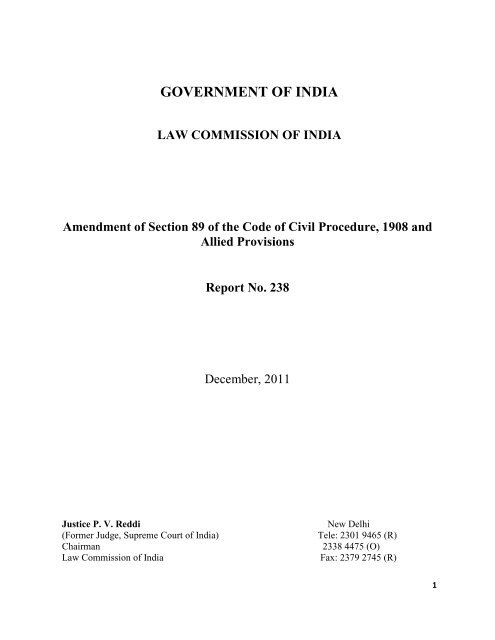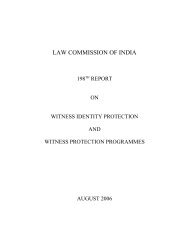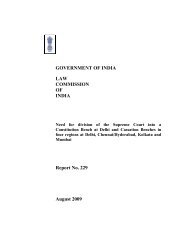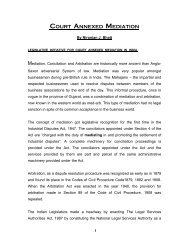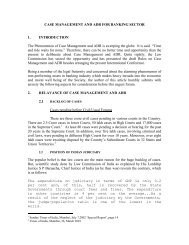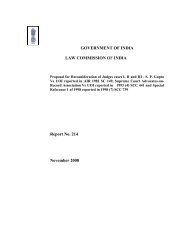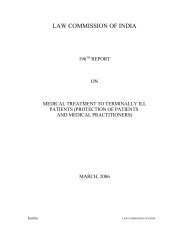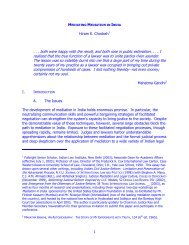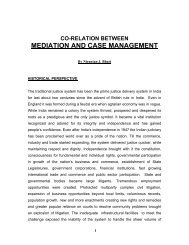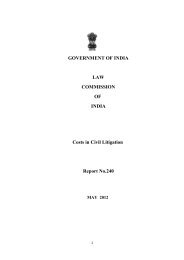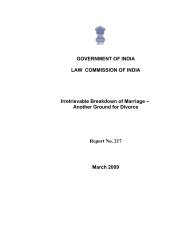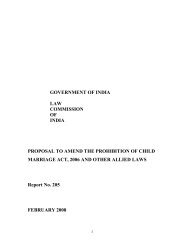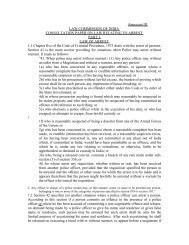Amendment of Section 89 of the Code of Civil Procedure 1908 and ...
Amendment of Section 89 of the Code of Civil Procedure 1908 and ...
Amendment of Section 89 of the Code of Civil Procedure 1908 and ...
- No tags were found...
You also want an ePaper? Increase the reach of your titles
YUMPU automatically turns print PDFs into web optimized ePapers that Google loves.
GOVERNMENT OF INDIALAW COMMISSION OF INDIA<strong>Amendment</strong> <strong>of</strong> <strong>Section</strong> <strong>89</strong> <strong>of</strong> <strong>the</strong> <strong>Code</strong> <strong>of</strong> <strong>Civil</strong> <strong>Procedure</strong>, <strong>1908</strong> <strong>and</strong>Allied ProvisionsReport No. 238December, 2011Justice P. V. Reddi(Former Judge, Supreme Court <strong>of</strong> India)ChairmanLaw Commission <strong>of</strong> IndiaNew DelhiTele: 2301 9465 (R)2338 4475 (O)Fax: 2379 2745 (R)1
D. O. No. 6(3)/190/2010 – LC (LS) 30 th December, 2011Dear Hon. Minister Salman Khurshid ji,The accompanying report relates to <strong>Section</strong> <strong>89</strong> <strong>of</strong> <strong>Civil</strong> <strong>Procedure</strong> <strong>Code</strong>.The Supreme Court observed in Afcons Infrastructure case (2010 8 SCC 24)that <strong>the</strong>re are many drafting errors in <strong>Section</strong> <strong>89</strong> <strong>and</strong> suggested amendmentsto <strong>the</strong> <strong>Section</strong> which may be considered by Law Commission <strong>of</strong> India. In orderto remove <strong>the</strong> deficiencies in <strong>Section</strong> <strong>89</strong> which is a pivotal provision forfacilitating dispute resolution in civil matters <strong>and</strong> to make it more simple <strong>and</strong>straightforward, <strong>the</strong> Law Commission has proposed amendments to <strong>Section</strong> <strong>89</strong>CPC as well as Order X Rules 1-A to 1-C. Fur<strong>the</strong>r, <strong>the</strong> amendment <strong>of</strong> <strong>Section</strong>16 <strong>of</strong> Court Fee Act has also been suggested. The amended provisions asproposed are found at paras 6.2, 6.3 <strong>and</strong> 6.4 <strong>of</strong> <strong>the</strong> Report.Shri Salman Khurshidji,Hon’ble Union Minister for Law & Justice,Shastri Bhavan,New Delhi.With regards <strong>and</strong> good wishesSd./(P.V. Reddi)Office: I. L. I. Building, Bhagw<strong>and</strong>as Road, New Delhi – 110 001Residence: 1, Janpath, New Delhi 110 011E-mail: pv_reddi@yahoo.co.in2
<strong>Amendment</strong> <strong>of</strong> <strong>Section</strong> <strong>89</strong> <strong>of</strong> <strong>the</strong> <strong>Code</strong> <strong>of</strong> <strong>Civil</strong> <strong>Procedure</strong>, <strong>1908</strong> <strong>and</strong> AlliedProvisionsCONTENTSPage No.1. INTRODUCTION 52. ANALYSIS OF SECTION <strong>89</strong> AND ITS SCHEME 6 - 103. THE BACKGROUND TO SECTION <strong>89</strong> 11 -134. DRAFTING ERRORS IN SECTION <strong>89</strong> – 14 -17AFCONS INFRASTRUCTURE CASE5. CHANGES CONSIDERED BROADLY 18 -236. AMENDMENTS PROPOSED 24 -277. RECOMMENDATIONS 283
ANNEXURE IEXTRACT OF SECTION 73(1) <strong>of</strong> AC ACT ANDSECTION <strong>89</strong> OF CPC 29 - 30ANNEXURE IIPARAGRAPHS 43 & 44 OF THEJUDGMENT IN AFCONSINFRASTRUCTURE CASE 31 - 334
1. Introduction1.1 The proliferation <strong>and</strong> pendency <strong>of</strong> litigation in <strong>Civil</strong> Courts for a variety <strong>of</strong> reasons hasmade it impracticable to dispose <strong>of</strong> cases within a reasonable time. The overburdened judicialsystem is not in a position to cope up with <strong>the</strong> heavy dem<strong>and</strong>s on it mostly for reasons beyond itscontrol. Speedy justice has become a casualty, though <strong>the</strong> disposal rate per-Judge is quite high inour country. The need to put in place Alternative Dispute Resolution (in short, “ADR”)mechanisms has been immensely felt so that <strong>the</strong> courts can <strong>of</strong>fload some cases from <strong>the</strong>irdockets. The ADR systems have been very successful in some countries, especially USAwherein <strong>the</strong> bulk <strong>of</strong> litigation is settled through one <strong>of</strong> <strong>the</strong> ADR processes before <strong>the</strong> case goesfor trial.1.2 Article 39A <strong>of</strong> <strong>the</strong> Constitution <strong>of</strong> India (enacted in 1976) enjoins that <strong>the</strong> State shallsecure that <strong>the</strong> operation <strong>of</strong> <strong>the</strong> legal system promotes justice, on a basis <strong>of</strong> equal opportunity,<strong>and</strong> shall, in particular, provide free legal aid, by suitable legislation or schemes, to ensure thatopportunities for securing justice are not denied to any citizen by reason <strong>of</strong> economic or o<strong>the</strong>rdisabilities. Thus, easy access to justice to all sections <strong>of</strong> people <strong>and</strong> provision <strong>of</strong> legal aid for <strong>the</strong>poor <strong>and</strong> needy <strong>and</strong> dispensation <strong>of</strong> justice by an independent Judiciary within a reasonable timeare <strong>the</strong> cherished goals <strong>of</strong> our Constitutional Republic <strong>and</strong> for that matter, <strong>of</strong> any progressivedemocracy.1.3 In our country, arbitration <strong>and</strong> mediation have been in vogue since long. Arbitration wasoriginally governed by <strong>the</strong> provisions contained in different enactments, including those in <strong>the</strong><strong>Code</strong> <strong>of</strong> <strong>Civil</strong> <strong>Procedure</strong>. The first Indian Arbitration Act was enacted in 1<strong>89</strong>9, which wasreplaced by <strong>the</strong> Arbitration Act, 1940 which in turn was replaced by <strong>the</strong> Arbitration <strong>and</strong>Conciliation Act <strong>of</strong> 1996. The mediation <strong>of</strong> informal nature was being adopted at <strong>the</strong> villagelevel to resolve petty disputes from times immemorial. Thanks to <strong>the</strong> innovative measures takenby <strong>the</strong> judiciary in some States, resolution <strong>of</strong> court litigation through Lok Adalats became quitepopular during 1970s <strong>and</strong> ’80s. With <strong>the</strong> advent <strong>of</strong> Legal Services Authorities Act 1987, LokAdalats <strong>and</strong> Legal Aid Schemes have received statutory recognition <strong>and</strong> become an integral <strong>and</strong>important part <strong>of</strong> <strong>the</strong> justice delivery system.5
2. Analysis <strong>of</strong> <strong>Section</strong> <strong>89</strong> <strong>and</strong> its Scheme2.1 By <strong>the</strong> <strong>Code</strong> <strong>of</strong> <strong>Civil</strong> <strong>Procedure</strong> (<strong>Amendment</strong>) Act 1999, section <strong>89</strong> had been introducedin <strong>the</strong> <strong>Code</strong> <strong>of</strong> <strong>Civil</strong> <strong>Procedure</strong>, <strong>1908</strong> <strong>and</strong> it became effective from 01-07-2002. <strong>Section</strong> <strong>89</strong> <strong>of</strong> <strong>the</strong>CPC reads as under:“<strong>89</strong>. Settlement <strong>of</strong> disputes outside <strong>the</strong> Court.- (1)Where it appears to <strong>the</strong> court that<strong>the</strong>re exist elements <strong>of</strong> a settlement which may be acceptable to <strong>the</strong> parties, <strong>the</strong> court shallformulate <strong>the</strong> terms <strong>of</strong> settlement <strong>and</strong> give <strong>the</strong>m to <strong>the</strong> parties for <strong>the</strong>ir observations <strong>and</strong>after receiving <strong>the</strong> observations <strong>of</strong> <strong>the</strong> parties, <strong>the</strong> court may reformulate <strong>the</strong> terms <strong>of</strong> apossible settlement <strong>and</strong> refer <strong>the</strong> same for –a) arbitration;b) conciliation;c) judicial settlement including settlement through Lok Adalat; ord) mediation(2) Where a dispute has been referred-(a) for arbitration or conciliation, <strong>the</strong> provisions <strong>of</strong> <strong>the</strong> Arbitration <strong>and</strong>Conciliation Act, 1996 shall apply as if <strong>the</strong> proceedings for arbitration orconciliation were referred for settlement under <strong>the</strong> provisions <strong>of</strong> that Act;(b) to Lok Adalat, <strong>the</strong> court shall refer <strong>the</strong> same to <strong>the</strong> Lok Adalat in accordancewith <strong>the</strong> provisions <strong>of</strong> sub-section (1) <strong>of</strong> section 20 <strong>of</strong> <strong>the</strong> Legal ServicesAuthorities Act, 1987 <strong>and</strong> all o<strong>the</strong>r provisions <strong>of</strong> that Act shall apply in respect <strong>of</strong><strong>the</strong> dispute so referred to <strong>the</strong> Lok Adalat;(c) for judicial settlement, <strong>the</strong> court shall refer <strong>the</strong> same to a suitable institution orperson <strong>and</strong> such institution or person shall be deemed to be a Lok Adalat <strong>and</strong> all<strong>the</strong> provisions <strong>of</strong> <strong>the</strong> Legal Services Authorities Act, 1987 shall apply as if <strong>the</strong>dispute were referred to a Lok Adalat under <strong>the</strong> provisions <strong>of</strong> that Act;(d) for mediation, <strong>the</strong> court shall effect a compromise between <strong>the</strong> parties <strong>and</strong>shall follow such procedure as may be prescribed.”6
The objective <strong>of</strong> <strong>Section</strong> <strong>89</strong> is to ensure that <strong>the</strong> court makes an endeavour to facilitateout-<strong>of</strong>-court settlements through one <strong>of</strong> <strong>the</strong> ADR processes before <strong>the</strong> trial commences.2.2 The related provisions which were incorporated by <strong>the</strong> same amendment Act are thosecontained in Rules 1A, 1B <strong>and</strong> 1C <strong>of</strong> Order X, CPC, which are extracted hereunder:“1A. Direction <strong>of</strong> <strong>the</strong> Court to opt for any one mode <strong>of</strong> alternative disputeresolution.—After recording <strong>the</strong> admissions <strong>and</strong> denials, <strong>the</strong> court shall direct <strong>the</strong> partiesto suit to opt ei<strong>the</strong>r mode <strong>of</strong> <strong>the</strong> settlement outside <strong>the</strong> court as specified in sub-section(1) <strong>of</strong> section <strong>89</strong>. On <strong>the</strong> option <strong>of</strong> <strong>the</strong> parties, <strong>the</strong> court shall fix <strong>the</strong> date <strong>of</strong> appearancebefore such forum or authority as may be opted by <strong>the</strong> parties.”“1B. Appearance before <strong>the</strong> conciliatory forum or authority.– where a suit is referredunder rule 1A, <strong>the</strong> parties shall appear before such forum or authority for conciliation <strong>of</strong><strong>the</strong> suit.”“1C. Appearance before <strong>the</strong> Court consequent to <strong>the</strong> failure <strong>of</strong> efforts <strong>of</strong>conciliation.- Where a suit is referred under rule 1A <strong>and</strong> <strong>the</strong> forum or authority to whom<strong>the</strong> matter has been referred is satisfied that it would not be proper in <strong>the</strong> interest <strong>of</strong>justice to proceed with <strong>the</strong> matter fur<strong>the</strong>r, <strong>the</strong>n it shall refer <strong>the</strong> matter again to <strong>the</strong> court<strong>and</strong> direct <strong>the</strong> parties to appear before <strong>the</strong> court on <strong>the</strong> date fixed by it.”2.3 With <strong>the</strong> introduction <strong>of</strong> <strong>the</strong>se provisions, a m<strong>and</strong>atory duty has been cast on <strong>the</strong> civilcourts to endeavour for settlement <strong>of</strong> disputes by relegating <strong>the</strong> parties to an ADR process. FiveADR methods are referred to in section <strong>89</strong>. They are: (a) Arbitration, (b) Conciliation, (c)Judicial settlement, (d) Settlement through Lok Adalat, <strong>and</strong> (e) Mediation.2.4 Arbitration as well as Conciliation are governed by <strong>the</strong> Arbitration <strong>and</strong> Conciliation Act,1996 (“AC” Act, for short) which superseded <strong>the</strong> previous Arbitration Act <strong>of</strong> 1940. Thearbitration unlike conciliation is an adjudicatory process. Once a civil dispute is referred toarbitration, <strong>the</strong> case will go outside <strong>the</strong> stream <strong>of</strong> <strong>the</strong> court permanently <strong>and</strong> will not come backto <strong>the</strong> court. However, in contrast, a dispute referred to conciliation which is a non-adjudicatoryprocess, does not go out <strong>of</strong> <strong>the</strong> domain <strong>of</strong> <strong>the</strong> court-process permanently. If <strong>the</strong>re is no amicablesettlement, <strong>the</strong> matter reverts back to <strong>the</strong> court which has to proceed with <strong>the</strong> trial after framing7
issues. The reference to arbitration or conciliation is only possible if <strong>the</strong>re is consent <strong>of</strong> <strong>the</strong>parties. In <strong>the</strong> absence <strong>of</strong> consent, <strong>the</strong> court cannot on its own refer <strong>the</strong> parties to arbitration orconciliation. This legal position is no longer in doubt in view <strong>of</strong> <strong>the</strong> recent judgment <strong>of</strong> SupremeCourt in Afcons Infrastructure Ltd. Vs. Cherian Varkey Consturction Co. (P) Ltd. 1 In <strong>the</strong> case <strong>of</strong>arbitration, if <strong>the</strong>re is no pre-existing arbitration agreement, <strong>the</strong> parties to suit can agree forarbitration by filing a joint memo or application <strong>and</strong> <strong>the</strong> court can <strong>the</strong>n refer <strong>the</strong> matter toarbitration <strong>and</strong> such arbitration will be governed by <strong>the</strong> provisions <strong>of</strong> <strong>the</strong> AC Act. The award <strong>of</strong><strong>the</strong> arbitrators is binding on <strong>the</strong> parties <strong>and</strong> is enforceable as if it is a decree <strong>of</strong> <strong>the</strong> court, in view<strong>of</strong> what has been said in section 36 <strong>of</strong> <strong>the</strong> AC Act. If any settlement is reached in <strong>the</strong> arbitrationproceedings, <strong>the</strong>n <strong>the</strong> award passed by <strong>the</strong> arbitrator on <strong>the</strong> basis <strong>of</strong> such agreed terms will have<strong>the</strong> same status <strong>and</strong> effect as any o<strong>the</strong>r arbitral award, vide section 30 <strong>of</strong> <strong>the</strong> AC Act.2.5 When <strong>the</strong> matter is settled through conciliation, <strong>the</strong> settlement agreement shall have <strong>the</strong>same status <strong>and</strong> effect as if it is an arbitral award (vide <strong>Section</strong> 74 <strong>of</strong> AC Act) <strong>and</strong> <strong>the</strong>refore it isenforceable as a decree <strong>of</strong> <strong>the</strong> court by virtue <strong>of</strong> section 36 <strong>of</strong> <strong>the</strong> AC Act. Similarly, when asettlement takes place before <strong>the</strong> Lok Adalat, <strong>the</strong> award <strong>of</strong> <strong>the</strong> Lok Adalat is deemed to be adecree <strong>of</strong> a civil court under section 21 <strong>of</strong> <strong>the</strong> Legal Services Authorities Act, 1987 (for short,“LSA Act”) <strong>and</strong> executable as such.2.6 The Supreme Court observed in <strong>the</strong> case <strong>of</strong> Afcons Infrastructure (supra): “As <strong>the</strong> courtcontinues to retain control <strong>and</strong> jurisdiction over <strong>the</strong> cases which it refers to conciliations or LokAdalats, <strong>the</strong> settlement agreement in conciliation or <strong>the</strong> Lok Adalat award will have to be placedbefore <strong>the</strong> court recording it <strong>and</strong> disposal in its terms”. Whe<strong>the</strong>r or not such a course <strong>of</strong> action isreally necessary, we shall discuss a little later.2.7 Coming to mediation, <strong>the</strong>re is practically no difference between conciliation <strong>and</strong>mediation <strong>and</strong> quite <strong>of</strong>ten <strong>the</strong>y are used as inter-changeable terms. Mediation is aimed atconciliation <strong>and</strong> conciliation has <strong>the</strong> elements <strong>of</strong> mediation. In <strong>the</strong> Dictionary <strong>of</strong> Modern LegalUsage by Bryan A. Garner, it is stated thus:1 (2010) 8 SCC 248
“The distinction between mediation <strong>and</strong> conciliation is widely debated among thoseinterested in ADR… Some suggest that conciliation is ‘a nonbinding arbitration’,whereas mediation is merely ‘assisted negotiation’. O<strong>the</strong>rs put it nearly <strong>the</strong> opposite way:conciliation involves a third party’s trying to bring toge<strong>the</strong>r disputing parties to help <strong>the</strong>mreconcile <strong>the</strong>ir differences, whereas mediation goes fur<strong>the</strong>r by allowing <strong>the</strong> third party tosuggest terms on which <strong>the</strong> dispute might be resolved. Still o<strong>the</strong>rs reject <strong>the</strong>se attempts atDIFFERENTIATION <strong>and</strong> contend that <strong>the</strong>re is no consensus about what <strong>the</strong> two wordsmean- that <strong>the</strong>y are generally interchangeable. Though a distinction would beconvenient, those who argue that usage indicates a broad synonymy are most accurate”.2.8 It may be noticed that section 73 <strong>of</strong> <strong>the</strong> AC Act contemplates <strong>the</strong> conciliator suggesting<strong>the</strong> terms <strong>of</strong> settlement. Therefore, <strong>the</strong> point <strong>of</strong> distinction noted in <strong>the</strong> above passage does nothold good in India. According to Shri Justice R. V. Raveendran, former Judge, Supreme Court <strong>of</strong>India <strong>and</strong> author <strong>of</strong> <strong>the</strong> judgment in Afcons Infrastructure case, where <strong>the</strong> conciliator is apr<strong>of</strong>essional trained in <strong>the</strong> art <strong>of</strong> mediation (as contrasted from a layman, friend, relative, wellwisher,or social worker acting as a conciliator), <strong>the</strong> process <strong>of</strong> conciliation is referred to asmediation. In cases where <strong>the</strong> third party assisting <strong>the</strong> parties to arrive at a settlement is not atrained pr<strong>of</strong>essional mediator, <strong>the</strong> process is referred to as conciliation. 2 It is however necessaryto point out that in many States, <strong>the</strong>re are trained mediators including legal pr<strong>of</strong>essionals <strong>and</strong><strong>the</strong>re are mediation centres managed by <strong>the</strong> Judiciary in few States. Mediation has emerged as ascience now.In Afcons Infrastructure case, <strong>the</strong> Supreme Court referred to <strong>the</strong> definition <strong>of</strong> mediationas given in <strong>the</strong> Model Mediation Rules, according to which “settlement by ‘mediation’ means <strong>the</strong>process by which a mediator appointed by parties or by <strong>the</strong> court, as <strong>the</strong> case may be,mediates <strong>the</strong> dispute between <strong>the</strong> parties to <strong>the</strong> suit by <strong>the</strong> application <strong>of</strong> <strong>the</strong> provisions <strong>of</strong> <strong>the</strong>Mediation Rules, 2003 in Part II, <strong>and</strong> in particular, by facilitating discussion between <strong>the</strong> partiesdirectly or by communicating with each o<strong>the</strong>r through <strong>the</strong> mediator, by assisting <strong>the</strong> parties inidentifying issues, reducing misunderst<strong>and</strong>ings, clarifying priorities, exploring areas <strong>of</strong>compromise, generating options in an attempt to solve <strong>the</strong> dispute <strong>and</strong> emphasizing that it is<strong>the</strong> parties’ own responsibility for making decisions which affect <strong>the</strong>m.” In short, mediation is a2 Justice R. V. Raveendran, “ <strong>Section</strong> <strong>89</strong> CPC: Need for an Urgent Relook”, (2007) 4 SCC J239
process <strong>of</strong> dispute-resolution by which <strong>the</strong> mediator assists <strong>and</strong> persuades <strong>the</strong> disputing parties toarrive at an amicable settlement.2.9 Judicial settlement means a compromise entered by <strong>the</strong> parties with <strong>the</strong> assistance <strong>of</strong> <strong>the</strong>court adjudicating <strong>the</strong> matter or ano<strong>the</strong>r judge to whom <strong>the</strong> court had referred <strong>the</strong> dispute. InBlack’s Law Dictionary, “judicial settlement” is defined as “<strong>the</strong> settlement <strong>of</strong> a civil case with<strong>the</strong> help <strong>of</strong> a Judge who is not assigned to adjudicate <strong>the</strong> dispute”.2.10 Referring to <strong>the</strong> inter-relation between section <strong>89</strong> <strong>and</strong> Order X Rule 1 A, <strong>the</strong> SupremeCourt pointed out that <strong>the</strong>re is no inconsistency. <strong>Section</strong> <strong>89</strong> confers <strong>the</strong> jurisdiction on <strong>the</strong> courtto refer a dispute to an ADR process, whereas Rules 1A to1C <strong>of</strong> Order X lay down <strong>the</strong> manner inwhich <strong>the</strong> jurisdiction is to be exercised by <strong>the</strong> court. The scheme is that <strong>the</strong> court explains <strong>the</strong>choices available regarding ADR process to <strong>the</strong> parties, permits <strong>the</strong>m to opt for a process byconsensus, <strong>and</strong> if <strong>the</strong>re is no consensus, proceeds to choose <strong>the</strong> process.10
3. The Background to <strong>Section</strong> <strong>89</strong>3.1 Before proceeding fur<strong>the</strong>r, we may refer to Statement <strong>of</strong> Objects <strong>and</strong> Reasons <strong>and</strong> Noteson Clauses attached to <strong>the</strong> <strong>Code</strong> <strong>of</strong> <strong>Civil</strong> <strong>Procedure</strong> (<strong>Amendment</strong>) Bill initiated in 1997.Statement <strong>of</strong> Objects <strong>and</strong> Reasons: “3. (d) with a view to implement <strong>the</strong> 129 th Report <strong>of</strong><strong>the</strong> Law Commission <strong>of</strong> India <strong>and</strong> to make conciliation scheme effective, it is proposed tomake it obligatory for <strong>the</strong> court to refer <strong>the</strong> dispute after <strong>the</strong> issues are framed forsettlement ei<strong>the</strong>r by way <strong>of</strong> arbitration, conciliation, mediation, judicial settlement orthrough Lok Adalat. It is only after <strong>the</strong> parties fail to get <strong>the</strong>ir disputes settled throughany one <strong>of</strong> <strong>the</strong> alternate dispute resolution methods that <strong>the</strong> suit shall proceed fur<strong>the</strong>r in<strong>the</strong> section in which it was filed.”Notes on clauses:“Clause 7 provides for <strong>the</strong> settlement <strong>of</strong> disputes outside <strong>the</strong> court. The provisions <strong>of</strong>clause 7 are based on <strong>the</strong> recommendations made by Law Commission <strong>of</strong> India <strong>and</strong>Malimath Committee. It was suggested by Law Commission <strong>of</strong> India that <strong>the</strong> court mayrequire attendance <strong>of</strong> any party to <strong>the</strong> suit or proceedings to appear in person with aview to arriving at an amicable settlement <strong>of</strong> dispute between <strong>the</strong> parties <strong>and</strong> make anattempt to settle <strong>the</strong> dispute between <strong>the</strong> parties amicably. Malimath Committeerecommended to make it obligatory for <strong>the</strong> court to refer <strong>the</strong> dispute, after issues areframed, for settlement ei<strong>the</strong>r by way <strong>of</strong> arbitration, conciliation, mediation, judicialsettlement or through Lok Adalat. It is only when <strong>the</strong> parties fail to get <strong>the</strong>ir disputessettled through any <strong>of</strong> <strong>the</strong> alternative dispute resolution methods that <strong>the</strong> suit couldproceed fur<strong>the</strong>r. In view <strong>of</strong> <strong>the</strong> above, clause 7 seeks to insert a new section <strong>89</strong> in <strong>the</strong><strong>Code</strong> in order to provide for alternate dispute resolution.”3.2.1 129 th Report (1988) <strong>of</strong> <strong>the</strong> Law Commission <strong>of</strong> India:The Law Commission recommended introduction <strong>of</strong> <strong>the</strong> Conciliation Court system whichhad been in vogue in Himachal Pradesh to deal with house rent/possession litigation as well aso<strong>the</strong>r litigations such as disputes as to inheritance/succession, partition, maintenance <strong>and</strong> willswhich are usually between near relations. The Commission referred to Order XXVII Rule 5B <strong>of</strong><strong>the</strong> CPC which bears <strong>the</strong> heading “Duty <strong>of</strong> court in suits against <strong>the</strong> Government or a public<strong>of</strong>ficer in arriving at a settlement” <strong>and</strong> <strong>the</strong>n observed: “Though rule 5B is limited in itsapplication to a suit to which <strong>the</strong> Government or <strong>the</strong> public <strong>of</strong>ficer acting in his <strong>of</strong>ficial capacity11
is a party, it is time to exp<strong>and</strong> <strong>the</strong> coverage <strong>of</strong> <strong>the</strong> method <strong>of</strong> resolution <strong>of</strong> disputes <strong>the</strong>reinprovided to all suits in civil courts, including <strong>the</strong> claim for compensation before <strong>the</strong> MotorAccidents Claims Tribunal. Rule 5B provides that in a suit to which it applies, it should be <strong>the</strong>duty <strong>of</strong> <strong>the</strong> court to make, in <strong>the</strong> first instance, every endeavour where it is possible to do soconsistently with <strong>the</strong> nature <strong>and</strong> circumstances <strong>of</strong> <strong>the</strong> case to assist <strong>the</strong> parties in arriving at asettlement in respect <strong>of</strong> <strong>the</strong> subject matter <strong>of</strong> <strong>the</strong> dispute. Where <strong>the</strong> court is <strong>of</strong> <strong>the</strong> opinion that<strong>the</strong>re is a reasonable possibility <strong>of</strong> a settlement between <strong>the</strong> parties to <strong>the</strong> suit, <strong>the</strong> proceedingsmay be adjourned for such period as it thinks fit to enable attempts to be made to effect suchsettlement. Rule 5B expects <strong>the</strong> court before which <strong>the</strong> suit is pending to itself attempt toconciliate <strong>the</strong> dispute”. The features <strong>of</strong> Conciliation Courts set up in Himachal Pradesh were<strong>the</strong>n adverted to by <strong>the</strong> Commission. The Commission, with a view to remove <strong>the</strong> difficultyexperienced by <strong>the</strong> Conciliation Court in H.P., in cases in which <strong>the</strong> parties do not appear inperson before <strong>the</strong> court, considered it necessary to introduce a provision in Order X <strong>of</strong> <strong>the</strong> CPCto <strong>the</strong> following effect:‘(i) The following may be added as sub-clause (c) immediately after sub-clause (b),clause (i) rule 2 <strong>of</strong> Order X <strong>of</strong> <strong>the</strong> <strong>Code</strong> <strong>of</strong> <strong>Civil</strong> <strong>Procedure</strong>:“may require <strong>the</strong> attendance <strong>of</strong> any party to <strong>the</strong> suit or proceedings, to appear inperson with a view to arriving at an amicable settlement <strong>of</strong> <strong>the</strong> dispute between<strong>the</strong> parties <strong>and</strong> make an attempt to settle <strong>the</strong> dispute between <strong>the</strong> partiesamicably”.’‘(ii) The following may be added as clause (3) immediately below clause (2) <strong>of</strong> rule 4 <strong>of</strong>Order X <strong>Code</strong> <strong>of</strong> <strong>Civil</strong> <strong>Procedure</strong>:“Where a party ordered to appear before <strong>the</strong> court in person with a view toarriving at an amicable settlement <strong>of</strong> <strong>the</strong> dispute between <strong>the</strong> parties, fails toappear in person before <strong>the</strong> court without lawful excuse on <strong>the</strong> date so appointed,<strong>the</strong> court may pronounce judgment against him or make such order in relation to<strong>the</strong> suit as it thinks fit”.’3.2.2 With <strong>the</strong>se additions, <strong>the</strong> Law Commission was <strong>of</strong> <strong>the</strong> opinion that <strong>the</strong> scheme will bevery effective <strong>and</strong> must be made obligatory in all courts, while removing <strong>the</strong> limitations that areimplicit in rule 5B <strong>of</strong> Order XXVII in <strong>the</strong> matter <strong>of</strong> application <strong>of</strong> <strong>the</strong> procedure to suits o<strong>the</strong>r12
than those set out <strong>the</strong>rein. In fact, <strong>the</strong> scheme must apply to all suits <strong>of</strong> a civil nature comingbefore <strong>the</strong> civil courts, it was observed.13
4. Drafting Errors in <strong>Section</strong> <strong>89</strong> - Afcons Infrastructure Case4.1. <strong>Section</strong> <strong>89</strong> enacted with a l<strong>of</strong>ty objective has revealed manifest drafting errors which inturn gave rise to complexities in underst<strong>and</strong>ing its true scope <strong>and</strong> purpose. The Supreme Courtaptly observed in Afcons Infrastructure case that <strong>the</strong> correct interpretation <strong>and</strong> underst<strong>and</strong>ing <strong>of</strong><strong>the</strong> provision has become “a trial judge’s nightmare”.4.2 The first <strong>and</strong> foremost incongruity (which has also been pointed out by <strong>the</strong> SupremeCourt in Afcons case) is related to sub-section (1) <strong>of</strong> section <strong>89</strong>, especially <strong>the</strong> words “shallformulate <strong>the</strong> terms <strong>of</strong> settlement”. The sub-section requires <strong>the</strong> court to formulate <strong>the</strong> terms <strong>of</strong>settlement <strong>and</strong> place <strong>the</strong>m before <strong>the</strong> parties “for <strong>the</strong>ir observations” <strong>and</strong> <strong>the</strong>n reformulate <strong>the</strong>terms <strong>of</strong> a possible settlement in <strong>the</strong> light <strong>of</strong> <strong>the</strong>ir observations. A literal reading fur<strong>the</strong>r showsthat on such reformulation, <strong>the</strong> court shall have to refer <strong>the</strong> dispute for one <strong>of</strong> <strong>the</strong> five ADRmethods, which is really meaningless. The language <strong>of</strong> section 73(1) <strong>of</strong> <strong>the</strong> AC Act has beenborrowed <strong>and</strong> practically transplanted into section <strong>89</strong> without appreciating <strong>the</strong> intended scope<strong>and</strong> purpose <strong>of</strong> section <strong>89</strong>. As pointed out by <strong>the</strong> Supreme Court in Afcons case, <strong>the</strong> formulation<strong>and</strong> reformulation <strong>of</strong> <strong>the</strong> terms <strong>of</strong> settlement by <strong>the</strong> court is wholly out <strong>of</strong> place at <strong>the</strong> stage <strong>of</strong>pre-ADR reference. At paragraph 16, <strong>the</strong> Supreme Court extracted section 73(1) <strong>of</strong> <strong>the</strong> AC Act<strong>and</strong> section <strong>89</strong> <strong>of</strong> <strong>the</strong> CPC (Annexure I) to highlight <strong>the</strong> absurdity <strong>and</strong> commented: “It is notpossible for courts to perform <strong>the</strong>se acts at a preliminary hearing to decide whe<strong>the</strong>r a caseshould be referred to an ADR process <strong>and</strong>, if so, which ADR process”. The Supreme Courtfur<strong>the</strong>r commented: “What is required to be done at <strong>the</strong> final stage <strong>of</strong> conciliation by aconciliator is borrowed lock, stock <strong>and</strong> barrel into <strong>Section</strong> <strong>89</strong> <strong>and</strong> <strong>the</strong> court is wrongly requiredto formulate terms <strong>of</strong> settlement <strong>and</strong> reformulate <strong>the</strong>m at a stage prior to reference to an ADRprocess”. The resultant situation has been graphically explained by <strong>the</strong> learned Judges in <strong>the</strong>following words:“If <strong>the</strong> reference is to be made to arbitration, <strong>the</strong> terms <strong>of</strong> settlement formulated by <strong>the</strong>court will be <strong>of</strong> no use, as what is referred to arbitration is <strong>the</strong> dispute <strong>and</strong> not <strong>the</strong> terms<strong>of</strong> settlement; <strong>and</strong> <strong>the</strong> arbitrator will adjudicate upon <strong>the</strong> dispute <strong>and</strong> give his decision byway <strong>of</strong> award. If <strong>the</strong> reference is to conciliation/mediation/Lok Adalat, <strong>the</strong>n drawing up<strong>the</strong> terms <strong>of</strong> <strong>the</strong> settlement or reformulating <strong>the</strong>m is <strong>the</strong> job <strong>of</strong> <strong>the</strong> conciliator or <strong>the</strong>14
mediator or <strong>the</strong> Lok Adalat, after going through <strong>the</strong> entire process <strong>of</strong>conciliation/mediation. Thus, <strong>the</strong> terms <strong>of</strong> settlement drawn up by <strong>the</strong> court will betotally useless in any subsequent ADR process. Why <strong>the</strong>n <strong>the</strong> courts should be burdenedwith <strong>the</strong> onerous <strong>and</strong> virtually impossible, but redundant, task <strong>of</strong> formulating <strong>the</strong> terms <strong>of</strong>settlement at pre-reference stage?”In this context, it may be mentioned that <strong>the</strong> Supreme Court in Salem Advocates BarAssociation vs. UOI 3 had equated <strong>the</strong> words “terms <strong>of</strong> settlement” to “summary <strong>of</strong> disputes” inan apparent attempt to resolve <strong>the</strong> anomaly.4.3 “How <strong>Section</strong> <strong>89</strong> should be interpreted”, was <strong>the</strong> next question addressed by <strong>the</strong> SupremeCourt in Afcons case. The learned Judge, after referring to <strong>the</strong> principles <strong>of</strong> interpretation insupport <strong>of</strong> <strong>the</strong> proposition that <strong>the</strong> language <strong>of</strong> a statute can be modified in exceptional cases toobviate an anomaly, laid down <strong>the</strong> legal position thus:“<strong>Section</strong> <strong>89</strong> has to be read with Rule 1-A <strong>of</strong> Order 10 which requires <strong>the</strong> court to direct<strong>the</strong> parties to opt for any <strong>of</strong> <strong>the</strong> five modes <strong>of</strong> alternative dispute resolution processes <strong>and</strong>on <strong>the</strong>ir option refer <strong>the</strong> matter. The said Rule does not require <strong>the</strong> court to ei<strong>the</strong>rformulate <strong>the</strong> terms <strong>of</strong> settlement or make available such terms <strong>of</strong> settlement to <strong>the</strong>parties to reformulate <strong>the</strong> terms <strong>of</strong> possible settlement after receiving <strong>the</strong> observations <strong>of</strong><strong>the</strong> parties. Therefore, <strong>the</strong> only practical way <strong>of</strong> reading <strong>Section</strong> <strong>89</strong> <strong>and</strong> Order 10 Rule1-A is that after <strong>the</strong> pleadings are complete <strong>and</strong> after seeking admissions/denialswherever required, <strong>and</strong> before framing issues, <strong>the</strong> Court will have recourse to <strong>Section</strong> <strong>89</strong><strong>of</strong> <strong>the</strong> <strong>Code</strong>. Such recourse requires <strong>the</strong> court to consider <strong>and</strong> record <strong>the</strong> nature <strong>of</strong> <strong>the</strong>dispute, inform <strong>the</strong> parties about five options available <strong>and</strong> take note <strong>of</strong> <strong>the</strong>ir preferences<strong>and</strong> <strong>the</strong>n refer <strong>the</strong>m to one <strong>of</strong> <strong>the</strong> alternative dispute resolution processes.”4.4 Secondly, <strong>the</strong> Supreme Court very rightly exposed <strong>the</strong> o<strong>the</strong>r obvious drafting error inmixing up <strong>the</strong> terms “judicial settlement” <strong>and</strong> “mediation”. The Supreme Court pointed out thatin order to give proper meaning to section <strong>89</strong>, <strong>the</strong> said two words should be interchanged.“Mediation” should find place in clause (c) <strong>of</strong> section <strong>89</strong> (2) <strong>and</strong> “judicial settlement” should betransferred to clause (d) in place <strong>of</strong> “mediation”. O<strong>the</strong>rwise, as succinctly pointed out by <strong>the</strong>3 (2005) 6 SCC 34415
apex Court, <strong>the</strong> anomaly would persist. This anomaly has been explained in <strong>the</strong> followingwords:“The first anomaly is <strong>the</strong> mixing up <strong>of</strong> <strong>the</strong> definitions <strong>of</strong> “mediation” <strong>and</strong> judicialsettlement” under clauses (c) <strong>and</strong> (d) <strong>of</strong> sub-section (2) <strong>of</strong> <strong>Section</strong> <strong>89</strong> <strong>of</strong> <strong>the</strong> <strong>Code</strong>. Clause(c) says that for“judicial settlement”, <strong>the</strong> court shall refer <strong>the</strong> same to a suitableinstitution or person who shall be deemed to be a Lok Adalat. Clause (d) provides thatwhere <strong>the</strong> reference is to “mediation”, <strong>the</strong> court shall effect a compromise between <strong>the</strong>parties by following such procedure as may be prescribed. It makes no sense to call acompromise effected by a court,, as “mediation”, as is done in clause (d). Nor does itmake any sense to describe a reference made by a court to a suitable institution or personfor arriving at a settlement as “judicial settlement”, as is done in clause (c).”4.5 In tune with <strong>the</strong> above discussion, <strong>the</strong> Supreme Court propounded <strong>the</strong> amendments in <strong>the</strong>following terms:“In view <strong>of</strong> <strong>the</strong> foregoing, it has to be concluded that proper interpretation <strong>of</strong> <strong>Section</strong> <strong>89</strong><strong>of</strong> <strong>the</strong> <strong>Code</strong> requires two changes from a plain <strong>and</strong> literal reading <strong>of</strong> <strong>the</strong> court. Firstly, itis not necessary for <strong>the</strong> court, before referring <strong>the</strong> parties to an ADR process, t<strong>of</strong>ormulate or reformulate <strong>the</strong> terms <strong>of</strong> a possible settlement. It is sufficient if <strong>the</strong> courtmerely describes <strong>the</strong> nature <strong>of</strong> dispute (in a sentence or two) <strong>and</strong> makes <strong>the</strong> reference.Secondly, <strong>the</strong> definitions <strong>of</strong> “judicial settlement” <strong>and</strong> “mediation” in clauses (c) <strong>and</strong> (d)<strong>of</strong> <strong>Section</strong> <strong>89</strong>(2) shall have to be interchanged to correct <strong>the</strong> draftsman’s error. Clauses(c) <strong>and</strong> (d) <strong>of</strong> <strong>Section</strong> <strong>89</strong>(2) <strong>of</strong> <strong>the</strong> <strong>Code</strong> will read as under when <strong>the</strong> two terms areinterchanged:(c) for “mediation”, <strong>the</strong> court shall refer <strong>the</strong> same to a suitable institution orperson <strong>and</strong> such institution or person shall be deemed to be a Lok Adalat <strong>and</strong> all<strong>the</strong> provisions <strong>of</strong> <strong>the</strong> Legal Services Authorities Act, 1987 (39 <strong>of</strong> 1987) shall applyas if <strong>the</strong> dispute were referred to a Lok Adalat under <strong>the</strong> provisions <strong>of</strong> that Act;(d) for “judicial settlement”, <strong>the</strong> court shall effect a compromise between <strong>the</strong>parties <strong>and</strong> shall follow such procedure as may be prescribed.”16
4.6 The Supreme Court <strong>the</strong>n declared: “The above changes made by interpretative processshall remain in force till <strong>the</strong> legislature corrects <strong>the</strong> mistakes, so that <strong>Section</strong> <strong>89</strong> is not renderedmeaningless <strong>and</strong> infructuous.” (emphasis supplied)17
5. Changes Considered Broadly5.1 In <strong>the</strong> light <strong>of</strong> <strong>the</strong> above observations, we are proposing amendments to section <strong>89</strong> aswell as <strong>the</strong> allied provisions substantially similar to those suggested by <strong>the</strong> Supreme Court.5..2 The Chairman, in <strong>the</strong> company <strong>of</strong> some o<strong>the</strong>r learned Members tried to get responsesfrom <strong>the</strong> judicial <strong>of</strong>ficers at Visakhapatnam <strong>and</strong> Delhi whe<strong>the</strong>r <strong>the</strong>y experienced or envisagedany practical difficulties in giving effect to <strong>the</strong> law laid down by <strong>the</strong> Supreme Court in AfconsInfrastructure case. Most <strong>of</strong> <strong>the</strong> judicial <strong>of</strong>ficers <strong>and</strong> even advocates did not express anyparticular difficulty. However, some have guardedly said that it is only in course <strong>of</strong> time, it willbe known whe<strong>the</strong>r any problem would crop up in implementing <strong>the</strong> section in its altered form.This qualificatory statement was more with reference to <strong>the</strong> category <strong>of</strong> cases described as fit ornot fit for adjudication by alternative methods. The Commission is <strong>of</strong> <strong>the</strong> view that <strong>the</strong> viewtaken by <strong>the</strong> Supreme Court on a careful analysis <strong>of</strong> <strong>the</strong> section in <strong>the</strong> light <strong>of</strong> its purpose <strong>and</strong>intendment is unexceptionable <strong>and</strong> meant to remove <strong>the</strong> ambiguity in section <strong>89</strong>. It is high timethat <strong>the</strong> section is recast on <strong>the</strong> lines suggested by <strong>the</strong> Supreme Court. In o<strong>the</strong>r words, <strong>the</strong> judgemadelaw has to be followed up by legislative action on <strong>the</strong> same lines. However, while recastingsection <strong>89</strong>, <strong>the</strong> Commission in <strong>the</strong> interests <strong>of</strong> clarity <strong>and</strong> aptness, has deviated a little from whathas been suggested by <strong>the</strong> Supreme Court in Afcons Infrastructure case.5.3 We shall briefly advert to <strong>the</strong> areas <strong>of</strong> deviation from <strong>the</strong> observations <strong>of</strong> <strong>the</strong> SupremeCourt in <strong>the</strong> aforementioned case. Interchanging clauses (c) & (d), as indicated by <strong>the</strong> learnedJudge in Afcons case, will no doubt give some sense to <strong>the</strong> provisions as <strong>the</strong>y st<strong>and</strong> now.However clause (c) dealing with mediation would still be inappropriate. There is no particularreason nor rationale in treating <strong>the</strong> mediator as Lok Adalat <strong>and</strong> investing <strong>the</strong> status <strong>of</strong> Lok Adalataward to <strong>the</strong> agreement reached in <strong>the</strong> course <strong>of</strong> mediation. A mediator can only facilitatedispute resolution between <strong>the</strong> parties <strong>and</strong> draw up <strong>the</strong> terms <strong>of</strong> settlement arrived at. It wouldbe inappropriate to regard it as an award passed by Lok Adalat by means <strong>of</strong> a deeming fiction<strong>and</strong> in doing so <strong>the</strong>re is no particular advantage. In fact, <strong>the</strong> appropriate course has beenindicated by <strong>the</strong> learned Judge at paragraph 39 <strong>of</strong> <strong>the</strong> judgment in <strong>the</strong> following words:“Where <strong>the</strong> reference is to a neutral third party (“mediation” as defined above) on a courtreference, though it will be deemed to be reference to Lok Adalat, as <strong>the</strong> court retains its control18
<strong>and</strong> jurisdiction over <strong>the</strong> matter, <strong>the</strong> mediation settlement will have to be placed before <strong>the</strong> courtfor recording <strong>the</strong> settlement <strong>and</strong> disposal.” Therefore, <strong>the</strong> more appropriate course would be torequire <strong>the</strong> mediator to submit <strong>the</strong> terms <strong>of</strong> settlement reached as a result <strong>of</strong> mediation to <strong>the</strong>court so that <strong>the</strong> court, after due scrutiny, can pass a decree in accordance with <strong>the</strong> compromisearrived at between <strong>the</strong> parties. Accordingly, we propose to recast <strong>the</strong> provision relating tomediation. Secondly, it is not necessary to provide that <strong>the</strong> award <strong>of</strong> Lok Adalat or <strong>the</strong>settlement arrived at through conciliation should be forwarded to <strong>the</strong> referring court forpassing a decree on <strong>the</strong> same lines, notwithst<strong>and</strong>ing certain observations made by <strong>the</strong>Hon’ble Supreme Court in paragraph 38 <strong>of</strong> Afcons to <strong>the</strong> following effect: “Though <strong>the</strong>settlement agreement in a conciliation or a settlement award <strong>of</strong> a Lok Adalat may not require <strong>the</strong>seal <strong>of</strong> approval <strong>of</strong> <strong>the</strong> court for its enforcement when <strong>the</strong>y are made in a direct reference byparties without <strong>the</strong> intervention <strong>of</strong> court, <strong>the</strong> position will be different if <strong>the</strong>y are made on areference by a court in a pending suit/proceedings. As <strong>the</strong> court continues to retain control <strong>and</strong>jurisdiction over <strong>the</strong> cases which it refers to conciliation, or Lok Adalat, <strong>the</strong> settlementagreement in conciliation or <strong>the</strong> Lok Adalat award will have to be placed before <strong>the</strong> court forrecording it <strong>and</strong> disposal in its terms.” As for <strong>the</strong> award <strong>of</strong> <strong>the</strong> Lok Adalat passed on <strong>the</strong> basis <strong>of</strong>agreed settlement, <strong>the</strong> award is deemed to be a decree <strong>of</strong> a civil court by virtue <strong>of</strong> section 21 <strong>of</strong><strong>the</strong> LSA Act. The Lok Adalat is presided over by a retired or sitting judicial <strong>of</strong>ficer <strong>and</strong> fur<strong>the</strong>rscrutiny by referring court would really be unnecessary. Fur<strong>the</strong>r, if a provision is made in section<strong>89</strong>, <strong>the</strong> award <strong>of</strong> Lok Adalat should be made a decree <strong>of</strong> <strong>the</strong> court concerned, it would introduceconflict with section 21. So also, if <strong>the</strong> settlement agreement au<strong>the</strong>nticated by <strong>the</strong> conciliator hasto be transformed into a decree <strong>of</strong> <strong>the</strong> court, it would conflict with section 74 <strong>of</strong> <strong>the</strong> AC Act.<strong>Section</strong> 74 enjoins that <strong>the</strong> settlement agreement has <strong>the</strong> same status <strong>and</strong> effect as an arbitralaward on agreed terms as if it is rendered by an arbitral tribunal under section 30 <strong>of</strong> <strong>the</strong> AC Act.To say that it shall have effect as a decree <strong>of</strong> <strong>the</strong> civil court would not be consistent with <strong>the</strong>existing provisions in <strong>the</strong> AC Act. To avoid <strong>the</strong>se complications, <strong>the</strong> Legislature need notnecessarily take <strong>the</strong> course <strong>of</strong> action indicated by <strong>the</strong> Supreme Court. <strong>Section</strong> <strong>89</strong> will serve itspurpose even if <strong>the</strong> fur<strong>the</strong>r step <strong>of</strong> passing a decree in terms <strong>of</strong> <strong>the</strong> award <strong>of</strong> Lok Adalat orconciliation agreement is not taken. On enquiry from some District Judges/Secretaries, LSAs,<strong>the</strong> Chairman <strong>of</strong> <strong>the</strong> Commission has come to know that as per <strong>the</strong> existing practice, <strong>the</strong> referringcourt, on receipt <strong>of</strong> intimation from Lok Adalat, records <strong>the</strong> factum <strong>of</strong> settlement leading to19
award <strong>of</strong> Lok Adalat <strong>and</strong> closes <strong>the</strong> case in <strong>the</strong> presence <strong>of</strong> parties or <strong>the</strong>ir counsel. No formalorder or decree is being passed. There could possibly be no objection in legitimizing suchprocedure. We may clarify that “mediation” being non-statutory st<strong>and</strong>s on a different footing.The imprimatur <strong>of</strong> <strong>the</strong> Court is required to make it effective.<strong>Section</strong> <strong>89</strong> <strong>and</strong> Order X, Rule 1A – <strong>the</strong> Reference <strong>Procedure</strong>5.4 An important question discussed by <strong>the</strong> Supreme Court is whe<strong>the</strong>r reference to ADRprocess is m<strong>and</strong>atory. In this regard, before we advert to <strong>the</strong> views expressed by <strong>the</strong> SupremeCourt in Afcons Infrastructure case, we may refer to what was said in Salem Bar Assn. casewhich considered <strong>the</strong> aspect <strong>of</strong> apparent conflict between <strong>the</strong> language <strong>of</strong> section <strong>89</strong> <strong>and</strong> Order10 Rule-1A. This is what <strong>the</strong> learned Judges said:“The intention <strong>of</strong> <strong>the</strong> legislature behind enacting <strong>Section</strong> <strong>89</strong> is that where it appears to<strong>the</strong> court that <strong>the</strong>re exists an element <strong>of</strong> a settlement which may be acceptable to <strong>the</strong>parties, <strong>the</strong>y, at <strong>the</strong> instance <strong>of</strong> <strong>the</strong> court, shall be made to apply <strong>the</strong>ir mind so as to optfor one or <strong>the</strong> o<strong>the</strong>r <strong>of</strong> <strong>the</strong> four ADR methods mentioned in <strong>the</strong> section <strong>and</strong> if <strong>the</strong> partiesdo not agree, <strong>the</strong> court shall refer <strong>the</strong>m to one or <strong>the</strong> o<strong>the</strong>r <strong>of</strong> <strong>the</strong> said modes. <strong>Section</strong> <strong>89</strong>uses both <strong>the</strong> words ‘shall’ <strong>and</strong> ‘may’ whereas Order X Rule 1-A uses <strong>the</strong> word ‘shall’but on harmonious reading <strong>of</strong> <strong>the</strong>se provisions it becomes clear that <strong>the</strong> use <strong>of</strong> <strong>the</strong> word‘may’ in <strong>Section</strong> <strong>89</strong> only governs <strong>the</strong> aspect <strong>of</strong> reformulation <strong>of</strong> <strong>the</strong> terms <strong>of</strong> a possiblesettlement <strong>and</strong> its reference to one <strong>of</strong> <strong>the</strong> ADR methods. There is no conflict. It is evidentthat what is referred to one <strong>of</strong> <strong>the</strong> ADR modes is <strong>the</strong> dispute which is summarized in <strong>the</strong>terms <strong>of</strong> settlement formulated or reformulated in terms <strong>of</strong> <strong>Section</strong> <strong>89</strong>.” (underlined foremphasis)5.5 This is how <strong>the</strong> two provisions have been reconciled. The underlined words give rise to anelement <strong>of</strong> ambiguity in underst<strong>and</strong>ing <strong>the</strong> said observations. However, in Afcons Infrastructurecase, <strong>the</strong> Supreme Court clarified <strong>the</strong> legal position more aptly by stating thus:‘<strong>Section</strong> <strong>89</strong> starts with <strong>the</strong> words “where it appears to <strong>the</strong> court that <strong>the</strong>re exist elements<strong>of</strong> a settlement”. This clearly shows that cases which are not suited for ADR processshould not be referred under <strong>Section</strong> <strong>89</strong> <strong>of</strong> <strong>the</strong> <strong>Code</strong>. The court has to form an opinionthat a case is one that is capable <strong>of</strong> being referred to <strong>and</strong> settled through ADR process.20
Having regard to <strong>the</strong> tenor <strong>of</strong> <strong>the</strong> provisions <strong>of</strong> Rule 1-A <strong>of</strong> Order 10 <strong>of</strong> <strong>the</strong> <strong>Code</strong>, <strong>the</strong>civil court should invariably refer cases to ADR process. Only in certain recognizedexcluded categories <strong>of</strong> cases it may choose not to refer to an ADR process. Where <strong>the</strong>case is unsuited for reference to any <strong>of</strong> <strong>the</strong> ADR processes, <strong>the</strong> court will have to brieflyrecord <strong>the</strong> reasons for not resorting to any <strong>of</strong> <strong>the</strong> settlement procedures prescribed under<strong>Section</strong> <strong>89</strong> <strong>of</strong> <strong>the</strong> <strong>Code</strong>. Therefore, having a hearing after completion <strong>of</strong> pleadings, toconsider recourse to ADR process under <strong>Section</strong> <strong>89</strong> <strong>of</strong> <strong>the</strong> <strong>Code</strong>, is m<strong>and</strong>atory. But actualreference to an ADR process in all cases is not m<strong>and</strong>atory. Where <strong>the</strong> case falls under anexcluded category, <strong>the</strong>re need not be reference to ADR process. In all o<strong>the</strong>r casesreference to ADR process is a must’.5.6 Then, <strong>the</strong> Supreme Court went on categorizing <strong>the</strong> cases, considered suitable or not suitablefor ADR process. It was observed that <strong>the</strong> following categories <strong>of</strong> cases are normally consideredto be not suitable for ADR process having regard to <strong>the</strong>ir nature:“(i) Representative suits under Order 1 Rule 8 CPC which involve public interest orinterest <strong>of</strong> numerous persons who are not parties before <strong>the</strong> court. (In fact, even acompromise in such a suit is a difficult process requiring notice to <strong>the</strong> personsinterested in <strong>the</strong> suit, before its acceptance).(ii) Disputes relating to election to public <strong>of</strong>fices (as contrasted from disputes betweentwo groups trying to get control over <strong>the</strong> management <strong>of</strong> societies, clubs, association,etc.)(iii) Cases involving grant <strong>of</strong> authority by <strong>the</strong> section after enquiry, as for example, suitsor grant <strong>of</strong> probate or letters <strong>of</strong> administration.(iv) Cases involving serious <strong>and</strong> specific allegations <strong>of</strong> fraud, fabrication <strong>of</strong> documents,forgery, impersonation, coercion etc.(v) Cases requiring protection <strong>of</strong> sections, as for example, claims against minors, deities<strong>and</strong> mentally challenged <strong>and</strong> suits for declaration <strong>of</strong> title against <strong>the</strong> Government.(vi) Cases involving prosecution for criminal <strong>of</strong>fences.”21
5.7 The Supreme Court also proceeded to enumerate <strong>the</strong> cases (whe<strong>the</strong>r pending in civilcourts or special tribunals), suitable for ADR processes. Such cases are classified under fivebroad headings:-(i) All cases relating to trade, commerce <strong>and</strong> contracts;(ii) All cases arising from strained relationship, such as matrimonial cases;(iii) All cases where <strong>the</strong>re is a need for continuation <strong>of</strong> <strong>the</strong> pre-existing relationship, suchas disputes between neighbour <strong>and</strong> members <strong>of</strong> societies;(iv) All cases relating to tortuous liability, including motor accident claims; <strong>and</strong>(v) All consumer disputes.5.8 Having thus categorized <strong>the</strong> cases normally ‘suitable’ <strong>and</strong> ‘not suitable’ for ADR process,<strong>the</strong> Supreme Court made it clear: “They are illustrative, which can be subjected to justexceptions or additions by <strong>the</strong> court/tribunal exercising its jurisdiction/discretion in referring adispute/case to an ADR process”.5.9 The Supreme Court also clarified:“Nei<strong>the</strong>r <strong>Section</strong> <strong>89</strong> nor Rule 1-A <strong>of</strong> Order 10 <strong>of</strong> <strong>the</strong> <strong>Code</strong> is intended to supersede ormodify <strong>the</strong> provisions <strong>of</strong> <strong>the</strong> Arbitration <strong>and</strong> Conciliation Act, 1996 or <strong>the</strong> Legal ServicesAuthorities Act, 1987. On <strong>the</strong> o<strong>the</strong>r h<strong>and</strong>, <strong>Section</strong> <strong>89</strong> <strong>of</strong> <strong>the</strong> <strong>Code</strong> makes it clear that two<strong>of</strong> <strong>the</strong> ADR processes – arbitration <strong>and</strong> conciliation, will be governed by <strong>the</strong> provisions<strong>of</strong> <strong>the</strong> AC Act <strong>and</strong> <strong>the</strong> two o<strong>the</strong>r ADR processes – Lok Adalat settlement <strong>and</strong> mediation…will be governed by <strong>the</strong> Legal Services Authorities Act. As for <strong>the</strong> last <strong>of</strong> <strong>the</strong> ADRprocesses – judicial settlement… <strong>Section</strong> <strong>89</strong> makes it clear that it is not governed by anyenactment <strong>and</strong> <strong>the</strong> section will follow such procedure as may be prescribed (byappropriate rules).”5.10 In this context, <strong>the</strong> ‘Summary’ given by <strong>the</strong> Supreme Court at paragraphs 43 & 44 <strong>of</strong> <strong>the</strong>judgment in Afcons Infrastructure case, is appended to this Report as ANNEXURE II.22
5.11 At <strong>the</strong> same time, <strong>the</strong> apex Court once again administered <strong>the</strong> caution that <strong>the</strong> procedure<strong>and</strong> consequential aspects referred to in paragraphs 43 & 44 are intended to be general guidelinessubject to such changes as <strong>the</strong> court concerned may deem fit with reference to specialcircumstances <strong>of</strong> a case. The sum <strong>and</strong> substance <strong>of</strong> what <strong>the</strong> court discussed elaborately is statedin paragraph 45 thus:“…Know <strong>the</strong> dispute; exclude unfit cases; ascertain consent for arbitration orconciliation; if <strong>the</strong>re is no consent, select Lok Adalat for simple cases <strong>and</strong> mediation forall o<strong>the</strong>r cases, reserving reference to Judge–assisted settlement only in exceptional orspecial cases.”23
6. <strong>Amendment</strong>s Proposed6.1 In <strong>the</strong> light <strong>of</strong> <strong>the</strong> foregoing discussion, <strong>the</strong> Commission recommends <strong>the</strong> followingamendments to <strong>the</strong> relevant provisions <strong>of</strong> CPC dealing with alternative dispute resolution <strong>and</strong>section 16 <strong>of</strong> <strong>the</strong> Court-fees Act, 1870.6.2 The following shall be substituted in <strong>the</strong> place <strong>of</strong> existing section <strong>89</strong> <strong>of</strong> <strong>the</strong> <strong>Code</strong> <strong>of</strong> <strong>Civil</strong><strong>Procedure</strong>, <strong>1908</strong>:“<strong>89</strong>: Settlement <strong>of</strong> disputes outside <strong>the</strong> court -1) Where it appears to <strong>the</strong> court, having regard to <strong>the</strong> nature <strong>of</strong> <strong>the</strong> dispute involved in<strong>the</strong> suit or o<strong>the</strong>r proceeding that <strong>the</strong> dispute is fit to be settled by one <strong>of</strong> <strong>the</strong> nonadjudicatoryalternative dispute resolution processes, namely, conciliation, judicialsettlement,settlement through Lok Adalat or mediation <strong>the</strong> court shall, preferably beforeframing <strong>the</strong> issues, record its opinion <strong>and</strong> direct <strong>the</strong> parties to attempt <strong>the</strong> resolution <strong>of</strong>dispute through one <strong>of</strong> <strong>the</strong> said processes which <strong>the</strong> parties prefer or <strong>the</strong> court determines.2) Where <strong>the</strong> parties prefer conciliation, <strong>the</strong>y shall furnish to <strong>the</strong> court <strong>the</strong> name or names<strong>of</strong> <strong>the</strong> conciliators <strong>and</strong> on obtaining his or <strong>the</strong>ir consent, <strong>the</strong> court may specify a timelimitfor <strong>the</strong> completion <strong>of</strong> conciliation. Thereupon, <strong>the</strong> provisions <strong>of</strong> sections 65 to 81 <strong>of</strong><strong>the</strong> Arbitration <strong>and</strong> Conciliation Act, 1996, as far as may be, shall apply <strong>and</strong> to this effect,<strong>the</strong> court shall inform <strong>the</strong> parties. A copy <strong>of</strong> <strong>the</strong> settlement agreement reached between<strong>the</strong> parties shall be sent to <strong>the</strong> court concerned. In <strong>the</strong> absence <strong>of</strong> a settlement, <strong>the</strong>conciliator shall send a brief report on <strong>the</strong> process <strong>of</strong> conciliation <strong>and</strong> <strong>the</strong> outcome<strong>the</strong>re<strong>of</strong>.3) Where <strong>the</strong> dispute has been referred:-a) for judicial-settlement, <strong>the</strong> Judicial Officer shall endeavour to effect acompromise between <strong>the</strong> parties <strong>and</strong> shall follow such procedure as may beprescribed;b) to Lok Adalat, <strong>the</strong> provisions <strong>of</strong> sub-sections (3) to (7) <strong>of</strong> section 20, sections21 <strong>and</strong> 22 <strong>of</strong> <strong>the</strong> Legal Services Authorities Act, 1987 shall apply in respect <strong>of</strong><strong>the</strong> dispute so referred <strong>and</strong> <strong>the</strong> Lok Adalat shall send a copy <strong>of</strong> <strong>the</strong> award to <strong>the</strong>24
court concerned <strong>and</strong> in case no award is passed, send a brief report on <strong>the</strong>proceedings held <strong>and</strong> <strong>the</strong> outcome <strong>the</strong>re<strong>of</strong>;c) for mediation, <strong>the</strong> court shall refer <strong>the</strong> same to a suitable institution or personor persons with appropriate directions such as time-limit for completion <strong>of</strong>mediation <strong>and</strong> reporting to <strong>the</strong> court.(4) On receipt <strong>of</strong> copy <strong>of</strong> <strong>the</strong> settlement agreement or <strong>the</strong> award <strong>of</strong> Lok Adalat, <strong>the</strong>court, if it finds any inadvertent mistakes or obvious errors, it shall draw <strong>the</strong> attention <strong>of</strong><strong>the</strong> conciliator or <strong>the</strong> Lok Adalat who shall take necessary steps to rectify <strong>the</strong> agreementor award suitably with <strong>the</strong> consent <strong>of</strong> parties.(5) Without prejudice to section 8 <strong>and</strong> o<strong>the</strong>r allied provisions <strong>of</strong> <strong>the</strong> Arbitration <strong>and</strong>Conciliation Act, 1996, <strong>the</strong> court may also refer <strong>the</strong> parties to arbitration if both partiesenter into an arbitration agreement or file applications seeking reference to arbitrationduring <strong>the</strong> pendency <strong>of</strong> a suit or o<strong>the</strong>r civil proceeding <strong>and</strong> in such an event, <strong>the</strong>arbitration shall be governed, as far as may be, by <strong>the</strong> provisions <strong>of</strong> <strong>the</strong> Arbitration <strong>and</strong>Conciliation Act, 1996. The suit or o<strong>the</strong>r proceeding shall be deemed to have beendisposed <strong>of</strong> accordingly”.6.3 The existing rule 1B <strong>of</strong> Order X <strong>of</strong> <strong>the</strong> <strong>Code</strong> <strong>of</strong> <strong>Civil</strong> <strong>Procedure</strong>, should be deleted. In <strong>the</strong> place <strong>of</strong>existing Rules 1-A <strong>and</strong> 1-C <strong>of</strong> Order X, <strong>the</strong> following rules shall be substituted:“1A. Direction <strong>of</strong> <strong>the</strong> court to opt for any one mode <strong>of</strong> alternative dispute resolution. -At <strong>the</strong> stage <strong>of</strong> framing issues or <strong>the</strong> first hearing <strong>of</strong> <strong>the</strong> suit, <strong>the</strong> court shall direct <strong>the</strong> parties toopt ei<strong>the</strong>r mode <strong>of</strong> <strong>the</strong> settlement outside <strong>the</strong> court as specified in sub-section (1) <strong>of</strong> section <strong>89</strong><strong>and</strong> for this purpose may require <strong>the</strong> parties to be personally present <strong>and</strong> in case <strong>of</strong> nonattendancewithout substantial cause, follow <strong>the</strong> procedure for compelling <strong>the</strong> attendance <strong>of</strong>witness. The court shall fix <strong>the</strong> date <strong>of</strong> appearance before such forum or authority or persons asmay be opted by <strong>the</strong> parties or chosen by <strong>the</strong> court.”“1B Appearance before <strong>the</strong> court consequent upon <strong>the</strong> failure <strong>of</strong> efforts <strong>of</strong> conciliation . -Where a suit is referred under rule 1A <strong>and</strong> <strong>the</strong> presiding <strong>of</strong>ficer <strong>of</strong> conciliation forum or authorityor <strong>the</strong> person to whom <strong>the</strong> matter has been referred is satisfied that it would not be proper in <strong>the</strong>interest <strong>of</strong> justice to proceed with <strong>the</strong> matter fur<strong>the</strong>r, in view <strong>of</strong> <strong>the</strong> st<strong>and</strong> taken by <strong>the</strong> respective25
parties, it shall refer <strong>the</strong> case back to <strong>the</strong> court who shall direct <strong>the</strong> parties to appear before it on<strong>the</strong> date fixed <strong>and</strong> proceed with <strong>the</strong> suit.”6.4.1 <strong>Section</strong> 16, Court-fees Act, 1870There is one more provision regarding which <strong>the</strong> Commission would like to focus <strong>the</strong>attention <strong>of</strong> <strong>the</strong> Government. That is section 16 <strong>of</strong> <strong>the</strong> Court-fees Act, 1870, which wasinserted by <strong>the</strong> same CPC <strong>Amendment</strong> Act by which section <strong>89</strong> was introduced. <strong>Section</strong>16 which was thus added to <strong>the</strong> Court-fees Act reads thus:“16. Refund <strong>of</strong> fee.-Where <strong>the</strong> section refers <strong>the</strong> parties to <strong>the</strong> suit to any one <strong>of</strong> <strong>the</strong> mode <strong>of</strong> settlement <strong>of</strong>dispute referred to in section <strong>89</strong> <strong>of</strong> <strong>the</strong> <strong>Code</strong> <strong>of</strong> <strong>Civil</strong> <strong>Procedure</strong>, <strong>1908</strong>, <strong>the</strong> plaintiff shallbe entitled to a certificate from <strong>the</strong> court authorizing him to receive back from <strong>the</strong>collector, <strong>the</strong> full amount <strong>of</strong> <strong>the</strong> fee paid in respect <strong>of</strong> such plaint.”6.4.2 Here again, <strong>the</strong>re is a clear drafting error which gives rise to conflict with section 21 <strong>of</strong><strong>the</strong> Legal Services Authorities Act, 1987. The LSA Act provides that <strong>the</strong> court-fees paid in acase placed before <strong>the</strong> Lok Adalat shall be refunded in <strong>the</strong> manner provided under <strong>the</strong> Court-feesAct, 1870 only if a compromise or settlement has been arrived at between <strong>the</strong> parties. However,<strong>Section</strong> 16 <strong>of</strong> <strong>the</strong> Court-fees Act, as <strong>the</strong> language st<strong>and</strong>s, goes fur<strong>the</strong>r <strong>and</strong> says that <strong>the</strong> court-feeis refundable merely on a reference by court to any ADR process. This would mean thatvirtually <strong>the</strong> court-fee paid in most <strong>of</strong> <strong>the</strong> suits will have to be refunded. What will happen if <strong>the</strong>reference to conciliation, mediation or Lok Adalat does not end in a settlement <strong>and</strong> <strong>the</strong> partiescome back to <strong>the</strong> court for adjudication? If <strong>the</strong> court-fees paid had already been refunded to <strong>the</strong>plaintiff when <strong>the</strong> reference was made, adjudication <strong>of</strong> <strong>the</strong> suit becomes free, <strong>the</strong>re being noprovision for collecting fresh court-fees. Obviously such a situation would not have beenintended. This aspect was highlighted by Shri Justice R.V. Raveendran in his lecture at NJABhopal 4 . The provision obligating <strong>the</strong> section to refund <strong>the</strong> entire court-fees paid on a merereference is also liable to be abused by <strong>the</strong> plaintiff. In fact, <strong>the</strong> Chairman <strong>of</strong> <strong>the</strong> Commissionheard such reports from <strong>the</strong> District Judges in some parts <strong>of</strong> <strong>the</strong> country. It was not intended by<strong>the</strong> Government (while introducing <strong>the</strong> Bill) or by <strong>the</strong> Legislature that <strong>the</strong> court-fees shall berefunded to <strong>the</strong> plaintiff once <strong>the</strong> reference is made to ADR process, irrespective <strong>of</strong> its outcome4 Supra Note 226
or <strong>the</strong> conduct <strong>of</strong> <strong>the</strong> plaintiff or petitioner. We may, in this context, refer to clause 35 <strong>of</strong> <strong>the</strong>‘Notes on Clauses’ accompanying <strong>the</strong> CPC (<strong>Amendment</strong>) Bill, 1997. It reads as follows:“Clause 35.- (<strong>Amendment</strong> to <strong>the</strong> Court-fees Act, 1870).The proposed amendment is consequential to <strong>the</strong> new section <strong>89</strong> <strong>of</strong> <strong>the</strong> <strong>Code</strong> <strong>of</strong> <strong>Civil</strong><strong>Procedure</strong>, <strong>1908</strong> proposed to be inserted vide clause 7 <strong>of</strong> <strong>the</strong> Bill so as to enable <strong>the</strong>party to claim refund <strong>of</strong> court-fee in case <strong>the</strong> matter in dispute is settled outside <strong>the</strong>section”.It clearly reflects <strong>the</strong> intention <strong>of</strong> <strong>the</strong> introducer <strong>of</strong> <strong>the</strong> Bill. However, <strong>the</strong> actual wording in <strong>the</strong>section is quite different. It does not appear that any conscious departure was intended at <strong>the</strong>time <strong>of</strong> enactment <strong>of</strong> <strong>the</strong> provision. It is clearly a case <strong>of</strong> draftsman employing <strong>the</strong> languagewhich does not accord with <strong>the</strong> intention behind <strong>the</strong> clause in <strong>the</strong> Bill. It is, <strong>the</strong>refore necessaryto amend <strong>the</strong> provision in <strong>the</strong> Court-fees Act, 1870 so as to bring it in conformity with section 21<strong>of</strong> <strong>the</strong> LSA Act, keeping in view <strong>the</strong> intendment <strong>and</strong> rationale <strong>of</strong> <strong>the</strong> provision. It may bementioned that <strong>the</strong> Court-fees Act <strong>of</strong> 1870 (Central enactment) does not have application in allStates. Almost all <strong>the</strong> States have <strong>the</strong>ir own court-fee enactments. <strong>Section</strong> 16 is thus enforceableonly in some Union Territories. However, some Judges, without being aware <strong>of</strong> this factualposition, have been following section 16 <strong>of</strong> <strong>the</strong> Court-fees Act, though <strong>the</strong>re is no similarprovision in <strong>the</strong> State enactment. Be that as it may, section 16 <strong>of</strong> <strong>the</strong> Court-fees Act, 1870,wherever it is applicable, needs to be suitably amended.6.4.3 In <strong>the</strong> place <strong>of</strong> <strong>the</strong> existing section 16 <strong>of</strong> <strong>the</strong> Court-fees Act, 1870, <strong>the</strong> following needs tobe substituted:“Where <strong>the</strong> court refers <strong>the</strong> parties to <strong>the</strong> suit or o<strong>the</strong>r proceeding to any one <strong>of</strong> <strong>the</strong>modes <strong>of</strong> settlement <strong>of</strong> dispute referred to in section <strong>89</strong> <strong>of</strong> <strong>the</strong> <strong>Code</strong> <strong>of</strong> <strong>Civil</strong><strong>Procedure</strong> <strong>and</strong> as a result <strong>the</strong>re<strong>of</strong> a compromise or settlement has been arrived atbetween <strong>the</strong> parties, <strong>the</strong> court-fees paid in such a case shall be refunded.”27
7. Recommendations7 <strong>Section</strong> <strong>89</strong> <strong>of</strong> <strong>the</strong> <strong>Civil</strong> <strong>Procedure</strong> <strong>Code</strong> which provides for settlement <strong>of</strong> disputes outside<strong>the</strong> court is inappropriately worded, as pointed out by <strong>the</strong> Supreme Court in <strong>the</strong> case <strong>of</strong> AfconsInfrastructure Ltd. vs. Cherian Varkey Construction Co. (P) LTD. 5 The language adopted hascreated difficulty in giving effect to <strong>the</strong> provision. <strong>Section</strong> <strong>89</strong> should be recast as indicated inparagraph 6.2. Secondly, <strong>the</strong> allied provisions, namely, Order X, rules 1A to 1C need recasting.The proposed amendment <strong>of</strong> <strong>the</strong> said rules in Order X is set out in paragraph 6.3. Thirdly,section 16 <strong>of</strong> <strong>the</strong> Court-fees Act, 1870 is required to be recast in order to ensure that unintendedbenefit does not go to <strong>the</strong> plaintiff. The proposed amendment is set out in paragraph 6.4.3.(Justice P.V. Reddi)Chairman(Justice Shiv Kumar Sharma)Member(Amarjit Singh)Member(Dr Brahm Agrawal)Member-Secretary5 Supra Note 128
EXTRACT OF SECTION 73(1) OF AC ACT AND SECTION <strong>89</strong> <strong>of</strong> CPCANNEXURE I73. Settlement agreement.(1) When it appears to <strong>the</strong> conciliator that <strong>the</strong>re exist elements <strong>of</strong> a settlement which may beacceptable to <strong>the</strong> parties, he shall formulate <strong>the</strong> terms <strong>of</strong> a possible settlement <strong>and</strong> submit <strong>the</strong>m to<strong>the</strong> parties for <strong>the</strong>ir observations. After receiving <strong>the</strong> observations <strong>of</strong> <strong>the</strong> parties, <strong>the</strong> conciliatormay reformulate <strong>the</strong> terms <strong>of</strong> a possible settlement in <strong>the</strong> light <strong>of</strong> such observations.(2)…(3) …(4)…<strong>89</strong>. Settlement <strong>of</strong> disputes outside <strong>the</strong> Court.(1) Where it appears to <strong>the</strong> court that <strong>the</strong>re exist elements <strong>of</strong> a settlement which may beacceptable to <strong>the</strong> parties, <strong>the</strong> court shall formulate <strong>the</strong> terms <strong>of</strong> settlement <strong>and</strong> give <strong>the</strong>m to <strong>the</strong>parties for <strong>the</strong>ir observations <strong>and</strong> after receiving <strong>the</strong> observation <strong>of</strong> <strong>the</strong> parties, <strong>the</strong> court mayreformulate <strong>the</strong> terms <strong>of</strong> a possible settlement <strong>and</strong> refer <strong>the</strong> same for-(a) arbitration;(b) conciliation(c) judicial settlement including settlement through Lok Adalat; or(d) mediation.(2) Where a dispute had been referred-(a) for arbitration or conciliation, <strong>the</strong> provisions <strong>of</strong> <strong>the</strong> Arbitration <strong>and</strong> Conciliation Act, 1996shall apply as if <strong>the</strong> proceedings for arbitration or conciliation were referred for settlement under<strong>the</strong> provisions <strong>of</strong> that Act.(b) to Lok Adalat, <strong>the</strong> court shall refer <strong>the</strong> same to <strong>the</strong> Lok Adalat in accordance with <strong>the</strong>provisions <strong>of</strong> sub-section (1) <strong>of</strong> section 20 <strong>of</strong> <strong>the</strong> Legal Services Authority Act, 1987 <strong>and</strong> allo<strong>the</strong>r provisions <strong>of</strong> that Act shall apply in respect <strong>of</strong> <strong>the</strong> dispute so referred to <strong>the</strong> Lok Adalat;(c) for judicial settlement, <strong>the</strong> court shall refer <strong>the</strong> same to a suitable institution or person <strong>and</strong>such institution or person shall be deemed to be a Lok Adalat <strong>and</strong> all <strong>the</strong> provisions <strong>of</strong> <strong>the</strong> Legal29
Services Authority Act, 1987 shall apply as if <strong>the</strong> dispute were referred to a Lok Adalat under <strong>the</strong>provisions <strong>of</strong> that Act;(d) for mediation, <strong>the</strong> court shall effect a compromise between <strong>the</strong> parties <strong>and</strong> shall follow suchprocedure as may be prescribed.30
ANNEXURE IIPARAGRAPHS 43 & 44 OF THE JUDGMENT IN AFCONS INFRASTRUCTURE CASE“43. We may summarize <strong>the</strong> procedure to be adopted by a court under section <strong>89</strong> <strong>of</strong> <strong>the</strong> <strong>Code</strong> asunder:(a) When <strong>the</strong> pleadings are complete, before framing issues, <strong>the</strong> court shall fix apreliminary hearing for appearance <strong>of</strong> parties. The court should acquaint itself with <strong>the</strong>facts <strong>of</strong> <strong>the</strong> case <strong>and</strong> <strong>the</strong> nature <strong>of</strong> <strong>the</strong> dispute between <strong>the</strong> parties.(b) The court should first consider whe<strong>the</strong>r <strong>the</strong> case falls under any <strong>of</strong> <strong>the</strong> category <strong>of</strong><strong>the</strong> cases which are required to be tried by courts <strong>and</strong> not fit to be referred to any ADRprocesses. If it finds <strong>the</strong> case falls under any excluded category, it should record a brieforder referring to <strong>the</strong> nature <strong>of</strong> <strong>the</strong> case <strong>and</strong> why it is not fit for reference to ADRprocesses. It will <strong>the</strong>n proceed with <strong>the</strong> framing <strong>of</strong> issues <strong>and</strong> trial.(c) In o<strong>the</strong>r cases (that is, in cases which can be referred to ADR processes) <strong>the</strong> courtshould explain <strong>the</strong> choice <strong>of</strong> five ADR processes to <strong>the</strong> parties to enable <strong>the</strong>m to exercise<strong>the</strong>ir option.(d) The court should first ascertain whe<strong>the</strong>r <strong>the</strong> parties are willing for arbitration. Thecourt should inform <strong>the</strong> parties that arbitration is an adjudicatory process by a chosenprivate forum <strong>and</strong> reference to arbitration will permanently take <strong>the</strong> suit outside <strong>the</strong> ambit<strong>of</strong> <strong>the</strong> court. The parties should also be informed that <strong>the</strong> cost <strong>of</strong> arbitration will have tobe borne by <strong>the</strong>m. Only if both parties agree for arbitration, <strong>and</strong> also agree upon <strong>the</strong>arbitrator, <strong>the</strong> matter should be referred to arbitration.(e) If <strong>the</strong> parties are not agreeable for arbitration, <strong>the</strong> court should ascertain whe<strong>the</strong>r <strong>the</strong>parties are agreeable for reference to conciliation which will be governed by <strong>the</strong>provisions <strong>of</strong> <strong>the</strong> AC Act. If all <strong>the</strong> parties agree for reference to conciliation <strong>and</strong> agreeupon <strong>the</strong> conciliator (s), <strong>the</strong> court can refer <strong>the</strong> matter to conciliation in accordance withsection 64 <strong>of</strong> <strong>the</strong> AC Act.(f) If parties are not agreeable for arbitration <strong>and</strong> conciliation, which is likely to happenin most <strong>of</strong> <strong>the</strong> cases for want <strong>of</strong> consensus, <strong>the</strong> court should, keeping in view <strong>the</strong>preferences/options <strong>of</strong> parties, refer <strong>the</strong> matter to any one <strong>of</strong> <strong>the</strong> o<strong>the</strong>r three o<strong>the</strong>r ADRprocesses: (a) Lok Adalat; (b) mediation by a neutral third-party facilitator or mediator;<strong>and</strong> (c) a judicial settlement, where a Judge assists <strong>the</strong> parties to arrive at a settlement.(g) If <strong>the</strong> case is simple which may be completed in a single sitting, or cases relating to amatter where <strong>the</strong> legal principles are clearly settled <strong>and</strong> <strong>the</strong>re is no personal animositybetween <strong>the</strong> parties (as in <strong>the</strong> case <strong>of</strong> motor accident claims), <strong>the</strong> court may refer <strong>the</strong>matter to Lok Adalat. In case where <strong>the</strong> questions are complicated or cases which may31
equire several rounds <strong>of</strong> negotiations, <strong>the</strong> court may refer <strong>the</strong> matter to mediation. Where<strong>the</strong> facility <strong>of</strong> mediation is not available or where <strong>the</strong> parties opt for <strong>the</strong> guidance <strong>of</strong> aJudge to arrive at a settlement, <strong>the</strong> court may refer <strong>the</strong> matter to ano<strong>the</strong>r Judge forattempting settlement.(h) If <strong>the</strong> reference to <strong>the</strong> ADR process fails, on receipt <strong>of</strong> <strong>the</strong> report <strong>of</strong> <strong>the</strong> ADR forum,<strong>the</strong> court shall proceed with hearing <strong>of</strong> <strong>the</strong> suit. If <strong>the</strong>re is a settlement, <strong>the</strong> court shallexamine <strong>the</strong> settlement <strong>and</strong> make a decree in terms <strong>of</strong> it, keeping <strong>the</strong> principles <strong>of</strong> Order23 Rule 3 <strong>of</strong> <strong>the</strong> <strong>Code</strong> in mind.(i) If <strong>the</strong> settlement includes disputes which are not <strong>the</strong> subject matter <strong>of</strong> <strong>the</strong> suit, <strong>the</strong>court may direct that <strong>the</strong> same will be governed by <strong>Section</strong> 74 <strong>of</strong> <strong>the</strong> AC Act (if it is aconciliation settlement) or <strong>Section</strong> 21 <strong>of</strong> <strong>the</strong> Legal Services Authorities Act, 1987 (if it isa settlement by a Lok Adalat or by mediation which is a deemed Lok Adalat). If <strong>the</strong>settlement is through mediation <strong>and</strong> it relates not only to disputes which are <strong>the</strong> subjectmatter<strong>of</strong> <strong>the</strong> suit, but also o<strong>the</strong>r disputes involving persons o<strong>the</strong>r than <strong>the</strong> parties to <strong>the</strong>suit, <strong>the</strong> court may adopt <strong>the</strong> principle underlying Order 23 Rule 3 <strong>of</strong> <strong>the</strong> <strong>Code</strong>. This willbe necessary as many settlement agreements deal with not only <strong>the</strong> disputes which are <strong>the</strong>subject-matter <strong>of</strong> <strong>the</strong> suit or proceeding in which <strong>the</strong> reference is made, but also o<strong>the</strong>rdisputes which are not <strong>the</strong> subject matter <strong>of</strong> <strong>the</strong> suit.(j) If any term <strong>of</strong> <strong>the</strong> settlement is ex facie illegal or unforceable, <strong>the</strong> court should draw<strong>the</strong> attention <strong>of</strong> parties <strong>the</strong>reto to avoid fur<strong>the</strong>r litigations <strong>and</strong> disputes aboutexecutability.44. The Court should also bear in mind <strong>the</strong> following consequential aspects, while giving effectto <strong>Section</strong> <strong>89</strong> <strong>of</strong> <strong>the</strong> <strong>Code</strong>:(i) If <strong>the</strong> reference is to arbitration or conciliation, <strong>the</strong> court has to record that <strong>the</strong>reference is by mutual consent. Nothing fur<strong>the</strong>r need be stated in <strong>the</strong> order-sheet.(ii) If <strong>the</strong> reference is to any o<strong>the</strong>r ADR process, <strong>the</strong> court should briefly record thathaving regard to <strong>the</strong> nature <strong>of</strong> dispute, <strong>the</strong> case deserves to be referred to Lok Adalat, ormediation or judicial settlement, as <strong>the</strong> case may be. There is no need for an elaborateorder for making <strong>the</strong> reference.(iii) The requirement in <strong>Section</strong> <strong>89</strong>(1) that <strong>the</strong> court should formulate or reformulate <strong>the</strong>terms <strong>of</strong> settlement would only mean that court has to briefly refer to <strong>the</strong> nature <strong>of</strong>dispute <strong>and</strong> decide upon <strong>the</strong> appropriate ADR process.(iv) If <strong>the</strong> Judge in charge <strong>of</strong> <strong>the</strong> case assists <strong>the</strong> parties <strong>and</strong> if settlement negotiationsfail, he should not deal with <strong>the</strong> adjudication <strong>of</strong> <strong>the</strong> matter, to avoid apprehensions <strong>of</strong> bias32
<strong>and</strong> prejudice. It is <strong>the</strong>refore advisable to refer cases proposed for judicial settlement toano<strong>the</strong>r Judge.(v) If <strong>the</strong> court refers <strong>the</strong> matter to an ADR process (o<strong>the</strong>r than Arbitration), it shouldkeep track <strong>of</strong> <strong>the</strong> matter by fixing a hearing date for <strong>the</strong> ADR Report. The period allottedfor <strong>the</strong> ADR process can normally vary from a week to two months (which may beextended in exceptional cases, depending upon <strong>the</strong> availability <strong>of</strong> <strong>the</strong> alternative forum,<strong>the</strong> nature <strong>of</strong> case etc.). Under no circumstances <strong>the</strong> court should allow <strong>the</strong> ADR processto become a tool in <strong>the</strong> h<strong>and</strong>s <strong>of</strong> an unscrupulous litigant intent upon dragging on <strong>the</strong>proceedings.(vi) Normally <strong>the</strong> court should not send <strong>the</strong> original record <strong>of</strong> <strong>the</strong> case when referring<strong>the</strong> matter for an ADR forum. It should make available only copies <strong>of</strong> relevant papers to<strong>the</strong> ADR forum. (For this purpose, when pleadings are filed <strong>the</strong> court may insist uponfiling <strong>of</strong> an extra copy). However if <strong>the</strong> case is referred to a court annexed mediationcentre which is under <strong>the</strong> exclusive control <strong>and</strong> supervision <strong>of</strong> a judicial <strong>of</strong>ficer, <strong>the</strong>original file may be made available wherever necessary.”33


